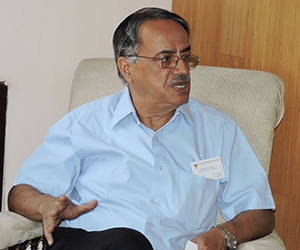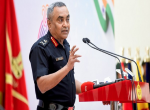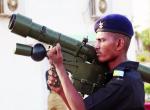It was only in early 1990’s that India realized that it was fast loosing strategic ground to China due to its lack of engagement with Myanmar. Not only security and stability in the border regions was crucial to India from internal security point of view but also constructive engagement with Myanmar and connectivity through it was very important for India to realize its ‘Look East Policy’ unveiled in early 1990s.
The military to military relations between the India and Myanmar gained traction with the goodwill visit of the then Chief of Army Staff, General B.C.Joshi to Myanmar (May 1994). Supply of some military hardware followed. Momentum to the defence relationship was further imparted when in January 2000 when a military delegation led by the then Indian Army Chief, Gen. VP Malik visited Myanmar and met Myanmar’s senior military elite to forge a military to military relationship which over the years has proved very fruitful. Since 2000, after the return visit of Gen. Maung Aye to India, bilateral annual border meetings between the two armies have been taking place regularly. India has also supplied a range of military hardware since then.
The Indian Prime Minster during his visit to Myanmar in April 2012 had also stressed on the need for maritime security cooperation and observed that both India and Myanmar need to “expand our security cooperation that is vital not only to maintain peace along our land borders but also to protect maritime trade which we hope will open up through the sea route between Kolkata and Sittwe.” In February, 2012 Myanmar Navy had taken part in joint naval exercises conducted by India with the participation of 14 nations’ navies (Milan series of naval exercises).
The recent visit of Mr. Antony to Myanmar (20-21 January, 2013) was a continuation of trend that has marked the growing defence cooperation between the two countries. After a degree of democratic reforms that were ushered in 2010, many military dignitaries from both sides have exchanged visits to enhance military to military cooperation and address mutual border security threats and challenges. In fact, in last two years or so the three Indian services chiefs have visited Myanmar to forge a closer defence relationship with Myanmar. This time the Defence Minster was accompanied by Army Commander of Kolkatta based Eastern Command and Vice Chief of Indian Navy which highlighted the fact that India was keen to further address its concerns regarding land and maritime security concerns in coordination with Myanmar armed forces.
It is important for India to build up capacities of the Myanmar’s armed forces especially in relation to developing its prowess in fighting the insurgents. Since the year 2000 there have been off and on coordinated operations along the borders to flush out the insurgents. The insurgents take advantage of the difficult terrain along the borders and lack of adequate controls along the borders to carry out attacks and then cross over to Myanmar.
The Defence Minister’s visit last month also came in the background of clashes between the Kachin insurgents and the Myanmar armed forces; Kachins remain the only group with which the Myanmar government has not been able to conclude a lasting ceasefire. Kachin Independent Organisation has been known to have cross-border linkages with Indian insurgents groups like ULFA in the shape of having provided shelter and advance military training to ULFA cadres. It was reported that there was a base of Indian insurgents in Kachin areas across the border. Last November, a high level 12-member team from Myanmar led by their Naga administration zone chairman U R Sanchyu and Pangsau sub-township representative had held a meeting with the Indian delegation at Jairampur in Arunachal Pradesh's Changlang district for discussions on cross-border crime, insurgent activities and other connected issues.
Further, NSCN is another active insurgent group which has trans- border affiliations with Myanmarese Nagas of Sagaing division opposite Indian states of Manipur and Nagaland. There were also reports early last year that a variety of North Eastern insurgents groups have joined together to coordinate their anti-India activities. ULFA, NSCN-K and PLA of Manipur seemed to have played key role in bringing these groups on a common platform. Sharing of information on operations and sources of weapons, facilitating training and providing mutual support and shelter along the Indo-Myanmar borders were some of the other objectives to be achieved by the so called “United Front’ composed of 14 anti-India insurgent groups.
In addition, the signing of a ceasefire agreement with Myanmarese Nagas of Sangaing division by the Myanmar government in May 2012 holds the prospects of the Indian Naga insurgent groups and their affiliates finding shelter and succor in their training bases. India was not informed about such an agreement and thus there was a certain degree of disappointment among the Indian security forces. With the Myanmar armed forces engaged in putting down the Kachin insurgency, it is quite possible that they were not willing to open another front that would have compounded their problems.
India has been providing training facilities to Myanmar armed forces in professional and technical courses; the vacancies in such courses for the Myanmar defence forces are being regularly enhanced. Maintenance of some Russian origin equipment is also being provided by the Indian defence forces. Building of defence infrastructure in the border areas has been another proposition which may fructify soon. This would facilitate quick movement and deployment of Myanmar forces to tackle insurgents and maintain law and order in border areas.
Even though the sector commanders on both sides are in touch with each other on a regular basis, India wants to intensify engagement so that insurgent groups are choked of arms supplies and cadre in the north-eastern states.
While for long Myanmar army has been pleading a lack of capacity in tackling the varied insurgent groups along the border, there is a view that Myanmar lacks the political will to act against some of these groups especially the Nagas’ insurgent outfits.
During his visit to Myanmar Mr. Antony met both the President of Myanmar and their Defence Minister. He conveyed the importance placed by India on enhancement of bilateral ties in all fields, including defence. He noted that the recent exchanges of visits between both countries at political and other levels had imparted a new momentum to the bilateral relationship.
Both the Defence Ministers deliberated on the following points:-
(a) Improvement of mechanisms for coordinating patrolling by the army along the land borders to prevent infiltration of insurgents
(b) Similar arrangements for patrolling maritime boundaries to curb activities of insurgent groups
(c) Ensuring that neither side allows the insurgents to use their territory for activities detrimental to each others’ security.
(d) Additional vacancies for training of Myanmar army personnel in Indian training academies
(e) Repair and training cover for Myanmar defence forces equipment of Russian origin
The visit also came at a time when China has expressed ‘grave concerns and dissatisfaction’ regarding some of the Myanmar army’s shells landing on their side of the border during the ongoing Kachin conflict. At the time of Indian Defence Minister to Naypidaw, a Chinese high level military delegation led by Lt-Gen Qi Jianguo, the deputy chief of general staff in the PLA met with Burma’s President Thein Sein in Yangon for strategic security consultations between the armed forces of China and Burma. However, the Indian and Chinese dignitaries’ visits seem to be unrelated.
Despite the recent opening up to the U.S. and the West due to its nascent democratic and economic reforms China’s strategic influence in Myanmar is considerable. India’s engagement with Myanmar and the western interest in Myanmar would contribute to moderating China’s influence. However, China due to its proximity and nature of relationship with the dispensation in Myanmar is unlikely to give free run to others. The multimodal linkages from Yunnan to Indian Ocean are critical to its energy security and economic growth.
It is quite evident that Tatmadaw would continue to remain the most important element for quite some time to come due to the nature of power distribution in Myanmar despite the baby steps towards democracy. Strengthening of defence relationship with Myanmar should proceed in congruence with political and economic engagement. Strategic imperatives can be underscored by the fact that India can ill afford to have another Pakistan on our East.
Published Date: 11th February 2013







.jpg)


Post new comment